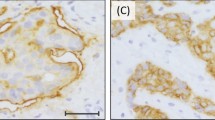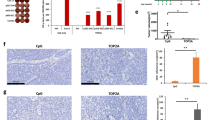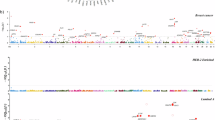Summary
The mucin MUC1 is expressed on breast cancers in an underglycosylated form compared to normal tissues and is therefore a potential target for cancer immunotherapy. MUC1 contains multiple tandem repeats of the 20 amino acid (aa) peptide (VTSAPDTRPAPGSTAPPAHG). The APDTRPA epitope is particularly immunogenic since it is recognized by a variety of murine monoclonal antibodies and by some sera and cytotoxic T-cells from unimmunized patients with epithelial cancers. We have prepared a 30 aa peptide (C)VTSAPDTRPAPGSTAPPAHGVTSAPDTRPA with cysteine at the N-terminal end, and used the cysteine for chemical conjugation to keyhole limpet haemocyanin (KLH). Six breast cancer patients immunized with this conjugate plus the immunological adjuvant QS-21 have all produced high titre (by ELISA) IgG and IgM antibodies against the 30 aa MUC1 peptide, but these sera reacted moderately, or not at all, with MUC1-positive tumour cells. To understand this specificity better, we prepared a series of smaller peptides to determine the epitopes recognized by these immune sera in inhibition assays. Only peptides containing APDTRPA at the C-terminal end were able to completely inhibit ELISA reactivity for the full 30 aa peptide. No sera were completely inhibited by APDTR, APDTRP, PDTRPA or any other peptides that did not contain the full APDTRPA epitope. Remarkably, sera from all six patients recognized this same epitope and were completely inhibited by only this epitope. The specificity of these sera (1) primarily for C-terminal APDTRPA, and the absence of this epitope at the C-terminal end of any tumour mucins, and (2) the N-terminal APDTRPA alanine, which is normally buried in the β turn MUC1 assumes in its secondary structure may explain the moderate to weak reactivity of these high titer sera against MUC1-positive tumour cells.
Similar content being viewed by others
Article PDF
Change history
16 November 2011
This paper was modified 12 months after initial publication to switch to Creative Commons licence terms, as noted at publication
References
Apostolopoulos, V., Osinski, C. & McKenzie, I. F. C. (1998). MUC1 cross-reactive galα (1,3) gal antibodies in humans switch immune responses from cellular to humoral. Nature Med 4: 315–320.
Ceriani, R. L., Peterson, J. A., Lee, J. Y., Moncada, R. & Blank, E. W. (1983). Characterization of cell surface antigens of human mammary epithilial cells with monoclonal antibodies, prepared against human milk fat globule. Somat Cell Genetics 9: 415–427.
Devine, P. L., Clark, B. A., Birell, G. W., Layton, G. T., Ward, B. G., Alegood, P. F. & McKenzie, I. F. C. (1991). The breast tumor-associated epitope defined by MoAb 3E1.2 is an O-linked mucin carbohydrate containing N-glycolylneuraminic acid. Cancer Res 51: 5826–5836.
Gilewski, T., Dickler, M., Adluri, R., Zhang, S., Houghton, A., Norton, L. & Livingston, P. O. (1998). Vaccination of high risk breast cancer patients (PTS) with MUC-1 (32aa) keyhole limpet hemocyarin (KLH) conjugate plus QS-21: Preliminary results. American Society of Clinical Oncology 17: 16–70.
Girling, A., Bartkova, J., Burchell, J., Gendler, S., Gillet, C. & Taylor-Papadimitrou, J. A. (1989). Core protein epitope of the polymorphic epithelial mucin detected by MoAb SM-3 is selectively expressed in a range of primary carcinomas. Int J Cancer 43: 1072–1076.
Gum, J. R., Byrd, J. C., Hicks, J. W., Tonbara, N. W., Lamport, D. T. A. & Kim, T. S. (1989). Molecular cloning of human intestinal mucin cDNAs. Sequence analysis and evidence for genetic polymorphism. J Biol Chem 264: 6480–6487.
Gum, J. R., Hicks, J. W., Swallow, D. M., Lagace, R. L., Byrd, J. C., Lamport, D. T. A., Siddiki, B. & Kim, Y. S. (1990). Molecular cloning of cDNAs derived from a novel human intestinal mucin gene. Biochem Biophys Res Commun 171: 407–415.
Hilkens, J., Buys, F. & Ligtenberg, M. (1989). Complexity of MAM-6, an epithelial Sialomucin associated with carcinomas. Cancer Res 49: 786–793.
Itzkowitz, S. H., Kjeldsen, T., Friera, A., Hakamoi, S., Yang, U. S. & Kim, Y. S. (1991). Expression of Tn, Sialosyl Tn, and T antigens in human pancreas. Gastroenterology 100: 1691–1700.
Jerome, K. R., Barnd, D. L., Bendt, K. M., Boyer, C. M., Taylor-Papadimitrou, J., McKenzie, I. F. C., Bast, R. C. Jr & Finn, O. J. (1991). Cytotoxic T-lymphocytes derived from patients with breast adenocarcinoma recognize an epitope present on the protein core of a mucin molecule preferentially expressed by malignant cells. Cancer Res 51: 2908–2916.
Karanikas, V., Hwang, L., Pearson, J., Ong, C., Apostolopoulos, V., Vaughan, H., Xing, P., Jamieson, G., Pietersz, G., Tait, B., Broadbent, R., Thynne, G. & McKenzie, I. F. C. (1997). Antibody and T cell responses of patients with adenocarcinoma immunized with mannan-MUC1 fusion protein. J Clin Invest 100: 2783–2792.
Karsten, U., Diotel, C., Klich, G., Paulsen, H., Goletz, S., Mnller, S. & Hanisch, F. G. (1998). Enhanced binding of antibodies to the DTR motif of MUC1 tandem repeat peptide is mediated by sit-specific glycosylation. Cancer Res 58: 2541–2549.
Lan, M. L., Hollingsworth, M. A. & Metzger, R. A. (1990). Polypeptide core of a human pancreatic tumor antigen. Cancer Res 50: 2997–3001.
McKenzie, I. F. C. & Xing, P-X (1990). Mucins in breast cancer: Recent immunological advances. Cancer Cells 2: 75–78.
Nieves, D., Henderson, R. A. & Finn, O. (1995). Identification of an HLA-A2-restricted epitope from the tandem repeat domain of the epithelial tumor antigen mucin. J Immunol 155: 4766–4774.
Price, M. R. (1988). High molecular weight epithelial mucin as markers in breast cancer. Eur J Clin Oncol 24: 1799–1804.
Price, M. R. & Tendler, S. J. B. (1993). Polymorphic epithelial mucin (PEM): molecular characteristics and association with breast cancer. The Breast 2: 3–11.
Price, M. R., Hudecz, F., O’Sullivan, C., Baldwin, R. W., Edwards, P. M. & Tendler, S. J. B. (1990). Immunological and structural features of the protein core of human polymorphic epithelial mucin. Mol Immunol 27: 795–802.
Sekine, H., Ohno, T. & Kufe, D. W. (1985). Purification and characterization of a high molecular weight glycoprotein detectable in human milk and breast carcinoma. J Immunol 135: 3610–3615.
Sell, S. (1990). Cancer associated carbohydrates identified by MoAbs. Progress Pathol 21: 1003–1019.
Soule, H. D., Vazquez, J., Long, A., Albert, S. & Brennan, M. (1973). A human cell line from a pleural effusin derived from a breast carcinoma. J Natl Cancer Inst 51: 1409–1416.
Stadie, T. R. E., Chai, W., Lawson, A. M., Byfield, P. G. H. & Hanisch, F. G. (1995). Studies on the order and site specificity of GalNAc transfer to MUC1 tandem repeats by UDP-GalNAc: polypeptideN-acetylgalactosaminyltransferase from milk or mammary carcinoma cells. Eur J Biochem 229: 140–147.
Strauss, G. J. & Dekker, J. (1992). Mucin-type glycoproteins. Crit Rev Biochem Mol Biol 27: 57–92.
Taylor-Papadimitrou, J., Petersen, J. A., Anklie, J., Burchell, J., Ceriani, R. L. & Bodmer, W. F. (1981). Monoclonal antibodies to epithelium specific components of the milk fat globule membrane: production and reaction with cells in culture. Int J Cancer 28: 17–21.
von Mensdorff-Pouilly, S., Gourevitch, M. M., Kenemans, P., Verstraeten, A. A., Litvinov, S. V., Van Kamp, G. J., Meijer, S., Vermorken, J. & Hilgers, J. (1996). Eur J Cancer 32A: 1325–1331.
Woolson, R. F. (1987). Statistical Methods for the Analysis of Biomedical Data, pp. 17–24. John Wiley & Sons: New York
Xing, P. X., Prenzoska, J., Quelch, K. & McKenzie, I. F. C. (1992). Second generation anti-muc 1 peptide MoAbs. Cancer Res 52: 2310–2317.
Zhang, S., Graeber, L., Helling, F., Ragupathi, G., Adluri, S., Lloyd, K. O. & Livingston, P. O. (1996). Augmenting the immunogenocity of synthetic Muc1 peptide vaccines in mice. Cancer Res 56: 3315–3319.
Author information
Authors and Affiliations
Rights and permissions
From twelve months after its original publication, this work is licensed under the Creative Commons Attribution-NonCommercial-Share Alike 3.0 Unported License. To view a copy of this license, visit http://creativecommons.org/licenses/by-nc-sa/3.0/
About this article
Cite this article
Adluri, S., Gilewski, T., Zhang, S. et al. Specificity analysis of sera from breast cancer patients vaccinated with MUC1-KLH plus QS-21. Br J Cancer 79, 1806–1812 (1999). https://doi.org/10.1038/sj.bjc.6990288
Received:
Revised:
Accepted:
Published:
Issue date:
DOI: https://doi.org/10.1038/sj.bjc.6990288
Keywords
This article is cited by
-
Comparison of antigen constructs and carrier molecules for augmenting the immunogenicity of the monosaccharide epithelial cancer antigen Tn
Cancer Immunology, Immunotherapy (2005)
-
Use of the anti-idiotype antibody vaccine TriAb after autologous stem cell transplantation in patients with metastatic breast cancer
Bone Marrow Transplantation (2000)



